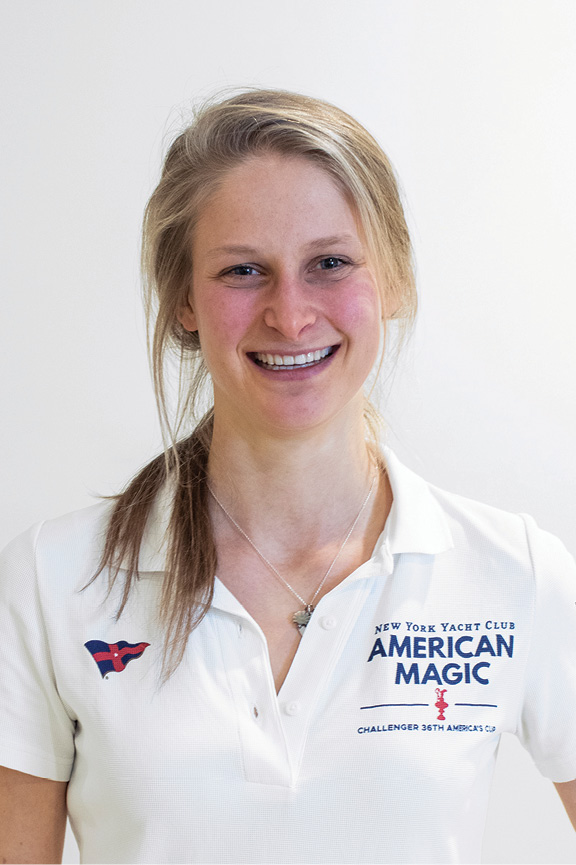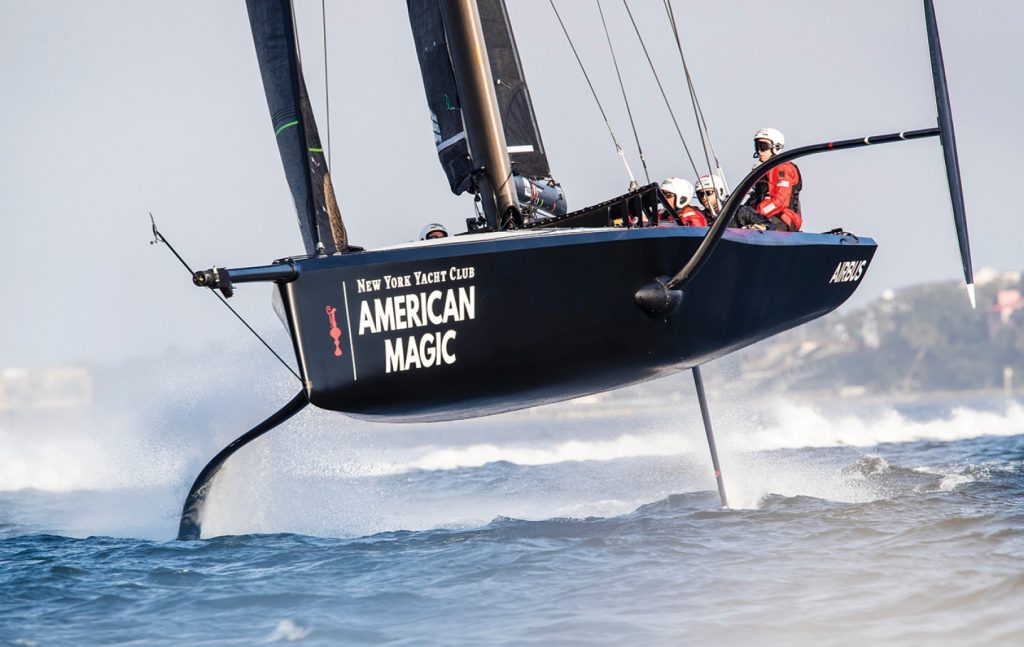Editor’s note: This interview is the third in a series we’re planning for each issue of WindCheck leading up to the 36th America’s Cup presented by Prada, which will be sailed March 6 – 21, 2021 in Auckland, New Zealand. This month we’re checking in with a member of the challenger’s design team, a talented engineer who’s a graduate of both MIT and the Oakcliff Sailing Sapling Program.

Robyn Lesh © Amory Ross/American Magic
WindCheck: Where did you grow up, and how old were you when you started sailing?
Robyn Lesh: I grew up in Everson, WA on 28 acres of land in the foothills of the Cascade Mountains. I was 6 days old when I went sailing for the first time.
WC: Please tell us about your degree in Mechanical-Ocean Engineering from MIT.
RL: I usually describe my degree at MIT as mechanical engineering for water-related applications. My senior capstone project was working with a team on an aluminum-powered fuel cell for an underwater autonomous vehicle.
WC: Did you sail at MIT? If so, did you skipper or crew and how did the team do in those years?
RL: I sailed for four years as a varsity athlete on the MIT Sailing Team. I skippered on the women’s team all four years as well as competed in singlehanded Lasers. On the women’s team we placed 8th and 5th at College Women’s Nationals, and I placed 10th at Singlehanded Nationals.
WC: What attracted you to Oakcliff Sailing, and what was your first Oakcliff clinic?
RL: I was attracted to Oakcliff by the opportunity to sail really awesome boats. At the time, Oakcliff’s High Performance fleet consisted of Olympic class 49ers and Olympic class Nacra 17s. The first Oakcliff clinic I attended was their College High Performance Clinic, which was designed to introduce high level college sailors to high performance Olympic class boats in a high intensity crash course. The clinic gave us the opportunity to sail skiffs and catamarans, be coached by excellent coaches, and learn from each other. I tried trapezing for the first time and was HOOKED (pun not intended)!
WC: What compelled you to return to Oakcliff after graduation?
RL: I returned after graduation to attend my third High Performance Clinic. After the clinic, I stayed at Oakcliff because of the stunning breadth of sailing opportunities, access to future connections, and constant learning.
WC: Please tell us about Oakcliff Foiling Camp, mastering the Waszp, and your success at the very first Waszp Nationals.
RL: Foiling Camp, similar to other high performance camps at Oakcliff, aims to provide access to rare foiling boats and develop sailors quickly by spending time in awesome boats directed by excellent coaches. I was in charge of the High Performance Fleet when we acquired our six Waszps.
One of the coolest things I learned at Oakcliff is how seemingly unrelated areas of sailing can have a huge amount of crossover. For example, 49er skiffs, Nacra 17 cats and foiling Waszps. The Waszp has about 6 inches of freeboard and a 12-inch wide hull, and the first time I stepped onboard (as much as you can “step on board” them) I instantly thought, ‘This is like a skiff…except tippy-er!…Oh look, looks like it works to play the main like a Nacra. Got it!’
That was a cool time because Waszps had just come out and everyone was figuring out how to sail them. I took it upon myself to learn as much as I could about how to sail them.
At Oakcliff I would look at the weather at the beginning of each week, decide by day if it would be better to sail in the morning or evening, write down my training plan, and sail for an hour either before or after work nearly every day.
I think my success at Waszp Nationals was from the fact that if I had written down that I was going to sail, I went out and sailed. If there were 4-6 knots and no chance of foiling, I still went sailing. My whole goal was to understand the boat. I believed that the most gains were to be made from a) being able to get foiling faster than anyone else and b) execute successful maneuvers. For these purposes, marginal foiling wind conditions were perfect. And when there was wind, my priorities were takeoffs and maneuvers. Straight line foiling is the most fun, but a racecourse isn’t a straight line!
WC: What were your responsibilities as Oakcliff’s High Performance Fleet Manager?
RL: This fleet consisted of seventeen 49er skiffs, four foiling Nacra 17s, two foiling Nacra 20s, two C-Foil Nacra 17s and six foiling Waszps. My responsibilities also included keelboat coaching in match and fleet racing, as well as assistant coaching the High Performance and Foiling Camps and continued personal training.

For every single gram added to New York Yacht Club American Magic’s yet-to-be-launched AC75 (their 38-foot test boat is pictured), a gram must be removed elsewhere. © Amory Ross/American Magic
WC: How did you meet Terry Hutchinson, New York Yacht Club American Magic’s Skipper and Executive Director, and how did that meeting lead to a job offer?
RL: I met Terry when he was visiting Oakcliff to finalize the partnership between American Magic and Oakcliff. The Oakcliff team sat down for lunch with Terry and gave our “elevator pitches” – who we are, our backgrounds, and what we are aiming for in our sailing futures. Terry was interested and asked for my email, and from then on was “Magic.”
WC: What are the most important things you learned at Oakcliff – and from Executive Dawn Riley – and how are you applying that knowledge to your job with New York Yacht Club American Magic?
RL: From Dawn: Own what you are and the choices you make. Be you bravely.
From Oakcliff: Keep your stuff together. (For Oakcliffies: Don’t be a magpie!) A team or a shop or a yard is made of lots of people working on lots of tasks. If everyone put their stuff in many places, even if it is very organized, the overall result is a mess!
WC: Where are you currently working, and what’s it like working with legendary designer Marcelino Botin?
RL: I am currently based in Bristol, Rhode Island after a short stint in the Marcelino’s in Spain design office. Marcelino is quiet and brilliant, but also friendly in a quiet way. The couple times he came to me while I was in Spain for information on the weight or center of gravity estimates, I felt very listened to and valued. Overall we have created a dynamic, much thanks to Design Coordinator Adolfo Carrau in Spain and Terry in the U.S., where we are a team and the common goal to create the fastest AC75 in the world has brought us together to go win the Cup. There is some organization but not a restrictive hierarchy of any sort. We do what will make the boat go fast and that typically means working together for the best idea, which can come from anyone.
WC: Were you involved with The Mule? If so, which parts of that boat did you work on?
RL: The Mule was a full team effort. As a new team, we used the opportunity to retrofit the Mule as a “practice run” for the AC75 race boats. I was involved with weight estimates and tracking from design through build, as well as design and production of most 3D-printed components on board. These range from mounts for installing sensors to human input devices for the sailors to control the boat while sailing.
WC: You’re responsible for the weight of everything on New York Yacht Club American Magic’s upcoming AC75. Please give us an example of the challenge of designing a part that’s both lightweight and strong enough for its intended purpose.
RL: My first reaction to the question, “What is challenging about designing to be both light enough AND strong enough?” – is Everything! The AC75s are constrained by the Class Rule, which in this iteration dictates a specific weight for the boat. The boat MUST weigh this number. The consequence of this is that if we add one gram somewhere, that gram must come out from somewhere else. This vitally links together weight decisions in all the departments, and it is my job that everyone knows where we are on weight and that we do everything we can to be as light as possible within the constraints of every part’s function.
WC: What’s the best thing about your job?
RL: Working with 3D printers, and the unpredictable variety of being a part of this team.
WC: Thank you very much Robyn. We can hardly wait to see the fruits of your labor on the podium in Auckland! ■



